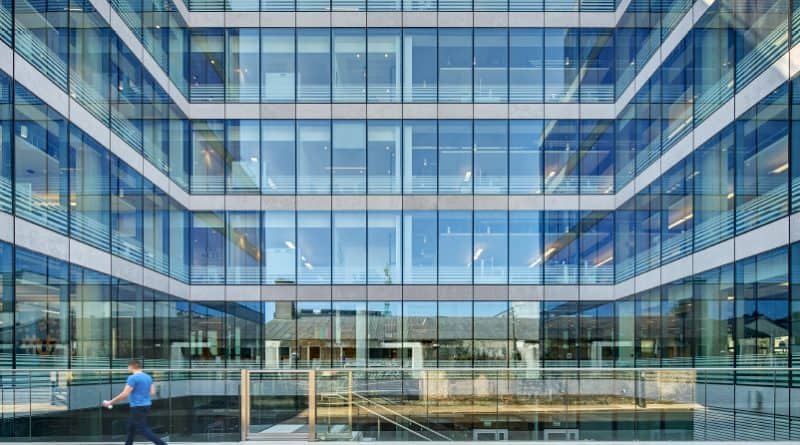Project in Focus | LinkedIn EMEA HQ
Making Connections. Irish building met with the team behind LinkedIn’s new Europe, Middle East & Africa headquarters having toured this world-class project.
LinkedIn’s new Europe, Middle East & Africa (EMEA) headquarters has now opened its doors in Dublin, Ireland. AECOM with RKD Architects delivered design and project management for the new sustainable 17,600 sq.m development. Walls Construction was the management contractor for the project. The new site provides capacity for over 1,000 staff for LinkedIn’s Irish base.
The development includes a commercial kitchen and restaurant, gym and wellness centre, flexible meeting space, feature stairs connecting each floor via an atrium and public realm improvements. The design process, was hugely enjoyable says David Petherbridge from RKD. “We started in late 2014 with the brief. LinkedIn are an amazing client – they brought us over to San Francisco, showed us around their other facilities so that we could fully understand what they needed.”
“The underlying basis of the design came from the fact that LinkedIn is all about connections and about forming connections, he says. Here in Ireland we are all about connections – it’s all about where you’re from and who you know. We were able to merge the idea of connectivity being such an integral part of being Irish with the LinkedIn way of doing things. That’s translated into how the floors are laid out, how we interact floor by floor and how we communicate within the building.”
Eileen Slamon, Workplace Manager at LinkedIn Ireland says that the building marks a new departure for the company. “We see this as a flagship location not just in Europe, but outside the US. It’s the first piece of real estate that LinkedIn has ever bought, so we are hugely proud of that. In looking at how we worked with all the project partners, we wanted to marry the reality of this being our headquarters and recognise that we were in the heart of Dublin. We achieved that with a combination of incorporating elements of design and uniquely Irish feels to things without being totally over the top.”
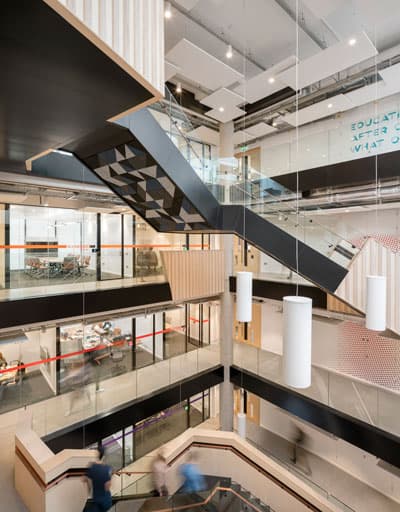 LinkedIn wanted quality and wanted to be different and the results are incredible. “There’s a lot of original artwork and graphics placed around the place and that extra level of detail is a hallmark of LinkedIn as a client – it’s just stunning as you walk around the building,” says Petherbridge. “You can see little added extras that you wouldn’t normally see in other buildings. For example, there is a corten steel, which wraps around corridor portals and then merges into the lift lobbies. Bespoke joinery pieces add unique visual experience to each of the lift lobbies such as the one on the first floor, which takes inspiration from the Giants Causeway.”
LinkedIn wanted quality and wanted to be different and the results are incredible. “There’s a lot of original artwork and graphics placed around the place and that extra level of detail is a hallmark of LinkedIn as a client – it’s just stunning as you walk around the building,” says Petherbridge. “You can see little added extras that you wouldn’t normally see in other buildings. For example, there is a corten steel, which wraps around corridor portals and then merges into the lift lobbies. Bespoke joinery pieces add unique visual experience to each of the lift lobbies such as the one on the first floor, which takes inspiration from the Giants Causeway.”
The flow of workspace within the building is unique to the LinkedIn way; something RKD enjoyed flexing its muscles in creating. “The workplace wraps around the perimeter of the building and it’s flexible, so as teams grow and contract, they can move around without having permanent walls in place,” explains Petherbridge. “There are pods of meeting rooms dotted around in strategic locations at the elbows of the building. The central space is all about communication; it’s all about interaction. There are breakout areas for informal meetings; there are more formal meeting areas too. The connecting open stairs randomly direct you to come around the atrium rather than take the shortest routes, so there are always chance meetings happening. The breakout areas and coffee stations are located at alternative corners as you go up the levels, so there is activity as you go up – it’s a buzzy space wherever you look. The more concentrated work that has to happen occurs away from the atrium and you can choose to work quietly or interactively in the space itself.”
These ‘chance encounters’ are key to the ethos of LinkedIn, explains Slamon. “They are the watercooler moments. With different teams spread out all over the building we encourage them to have their meetings all over the place; so that they can have a different aspect and bump into other people from different teams and contexts.”
The atrium was a key aspect of the LinkedIn design brief, says Petherbridge. “LinkedIn wanted to have a space which would accommodate as many staff as possible in one space for an all hands meeting or presentation. We designed a central bleachers area specifically for this but there’s a real sense of community in the whole area when an event is happening. The secret in accommodating that many people is in creating spaces behind walls. The workspace is really well planned and it’s a really pleasant place to be. Currently there are just under 800 people working in it.”
 Breakout spaces where staff can come and enjoy a coffee and a snack are essential to the LinkedIn way of working, says Eileen Slamon, and were an integral part of the design brief. “Our markets extend beyond a typical Irish day, so we have people who start early or finish late, so it’s essential for us to have food and drinks available.”
Breakout spaces where staff can come and enjoy a coffee and a snack are essential to the LinkedIn way of working, says Eileen Slamon, and were an integral part of the design brief. “Our markets extend beyond a typical Irish day, so we have people who start early or finish late, so it’s essential for us to have food and drinks available.”
The finishes within the building really showcase the level of detail RKD and LinkedIn outlined in their initial design brief. The aim was to harness the old and the new, says Petherbridge. “We’ve tried to build in some raw building materials like exposed concrete and have softened it with timber, copper and tiling – it works in a modern sense without appearing gimmicky,” he attests. “There is a copper handrail that wanders through the building linking key areas. We had a really open-minded client who wanted us to explore our creative side and take inspiration from everything we’ve seen. The bleachers are integrated at the base of the atrium. The large visual display links perhaps to a presenter that mightn’t be in Dublin. There are sliding acoustic screens that can come around and accommodate a session that’s separate from the restaurant. We were given the time to really develop and evolve the design and if you look around, every aspect in the building has been considered.”
The details, says Eileen Slamon, are what makes the building uniquely LinkedIn. “There are multiple textures and finishes, and lots of different interest points and people have their favourites. The building is everything to everybody in different ways. Having worked on the project for so long, it’s only in the last few weeks I’ve had a chance to appreciate the little details. I would say that our way-finding signage is uniquely Irish. It speaks to what LinkedIn is all about, which is a community of connections.”
Integrating the latest technological innovations was essential, says Slamon. “We have deployed a lot of technology. We have video-conferencing availability in every single room irrespective of whether you have clients or it’s a one-person drop in space. We’ve also deployed a solution called Event Space, where you can book a room through your outlook calendar. You have to tap in to start your meeting, so it avoids rooms being unused.” Analysis was key in determining the requirements in terms of meeting spaces, says Petherbridge. “The perception from LinkedIn at the beginning was that they needed lots of big spaces, but when we did the analysis, it was actually lots of smaller rooms, which were needed. It meant we could create a lot more variety in terms of offering the staff meeting rooms to meet their requirements.”
 The building is designed to a LEED Gold standard owing to its various sustainable attributes, and this was a core aim throughout the project, says Eileen Slamon. “We are very mindful of the total cost of running the building. You spend X in terms of construction but you need to look at how you’re going to operate the space. It was essential that we would implement solutions that were very good from a sustainable perspective both in terms of construction but also in the ongoing running of the building,” she says. “We are delighted that we are using 100% renewable energy, we are partnering with Energia on that and it was a very important piece for us, not only in terms of being LinkedIn Ireland but also in terms of what it shows other companies across the region. There is an awful lot of work being done by our colleagues in the US in terms of minimising our footprint and how efficient we are in terms of water and energy usage. We have some little touches like in the bathroom the taps are on a timer to give you sufficient time to wash your hands but not waste water – all those little things come together in the bigger picture.”
The building is designed to a LEED Gold standard owing to its various sustainable attributes, and this was a core aim throughout the project, says Eileen Slamon. “We are very mindful of the total cost of running the building. You spend X in terms of construction but you need to look at how you’re going to operate the space. It was essential that we would implement solutions that were very good from a sustainable perspective both in terms of construction but also in the ongoing running of the building,” she says. “We are delighted that we are using 100% renewable energy, we are partnering with Energia on that and it was a very important piece for us, not only in terms of being LinkedIn Ireland but also in terms of what it shows other companies across the region. There is an awful lot of work being done by our colleagues in the US in terms of minimising our footprint and how efficient we are in terms of water and energy usage. We have some little touches like in the bathroom the taps are on a timer to give you sufficient time to wash your hands but not waste water – all those little things come together in the bigger picture.”
The key in designing a building with such a sustainable footprint is in making it invisible, says David Petherbridge. “Using an experienced team you can incorporate these things into a design without impacting the end user. This is a very green building, but not in a way that makes you feel uncomfortable. The performance of the building itself is the key to its energy efficiency. If you crack that you’re solving the problem by effectively keeping it outside the building. Our air-conditioning and airflow systems are high performance but also high efficiency and little touches are in the background.”
The experience of working with LinkedIn to create this space is one that RKD will not forget. “The building is a facilitator of the new workplace,” says David Petherbridge. “This is what we consider to be the new workspace in terms of how it operates, how people interact and how they go about their day to day business. Their activities get built around that. Rather than being an inconvenience, everything is convenient to people who work here. It was a privilege to work with a client like LinkedIn and to see it come to fruition so close to what we envisioned back at the beginning of the process. It’s a testament to what we have achieved together.”
Projecting Success
Irish building speaks to AECOM about their role as the design, project and cost management provider of the LinkedIn EMEA headquarters.
40% of construction projects are late, 31% are over budget, and 19% fail to meet expectations* BIS, CITB, Glenigan 2015. AECOM and architectural partner RKD Architects defied these market norms; delivering the impressive 17,650 sq ft LinkedIn project 100% on time, 100% on budget, and with 100% client satisfaction.
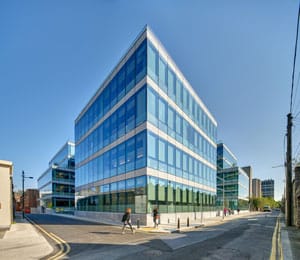 As the fully-integrated turnkey service provider for the design, project and cost management of the LinkedIn EMEA headquarters, AECOM’s Greg Flynn, Project Manager and Director, explains how they did it. “Impeccable planning, constant communication, and collaborative technologies were the key to delivering this project on time and on budget.’
As the fully-integrated turnkey service provider for the design, project and cost management of the LinkedIn EMEA headquarters, AECOM’s Greg Flynn, Project Manager and Director, explains how they did it. “Impeccable planning, constant communication, and collaborative technologies were the key to delivering this project on time and on budget.’
AECOM’s work commenced at the very start of the project, from site search, technical due diligence and site acquisition; through to designing, costing, procuring and managing the works on site.
As one of the leaders of the project management industry, there were no challenges on the project that were insurmountable, says Flynn. “The volume of information was one of the challenges we came up against, and our response to that was to set up collaborative technologies in the form of document management systems and information and communication tools,” he explains. “We used ProjectWise as our collaborative suite to be the document and information controller with our design team, who were predominantly based in Ireland but also overseas. Our client was based in Dublin and on the West Coast of the States. To avoid duplication and huge volumes of information being distributed on email, and to increase efficiency and greater utilisation of valuable team resources; we had a direct upload system whereby the team would upload information into ProjectWise and be immediately accessible to everyone on the project team. The job was big and it was moving at a very fast pace. Add to that the amount of people on the job in so many different geographical areas, and you’ll see that unless we had been equipped to utilise technology to maintain efficiencies, we would have been dead in the water.”
To enable the delivery of the design in parallel with the fast-track construction approach, it was decided that the project would be delivered using a Management Contracting procurement method – where the design was completed concurrently with the progression of the project on site and trade packages were let as needed by the programme. “That was a key part for us, enabling to eat away at the work on the programme once the site was acquired by LinkedIn,” maintains Greg Flynn. “That gave us a great head start. We then brought in a management contractor, which meant two contracts; between LinkedIn and AECOM for the design, procurement, project and cost management services; and a second contract between LinkedIn and Walls for the construction work.
This is a relatively unique situation in that it is highly unusual in the Irish market that you would have only two lead service providers on a programme of this size. We were able to manage the size of the project because we had the technology and the structure and resources to call on very quickly.”
AECOM also completed the structural engineering of the building, which consists of a braced reinforced concrete framed structure and traditional flat slab construction. The basement structure is formed by a perimeter secant pile wall due to the presence of a high ground water table. The building frame is also supported on the perimeter secant piles and internally on pile foundations. Primary structural steelwork frames support the open-air plantrooms on the fifth floor and the pop-up atrium roof. Open-air terraces occur on every level of the building from second floor to fifth floor.
The façade of the building combines stringent thermal standards to reduce heating and cooling demands whilst allowing the necessary daylight to the occupied space. The façade system uses an active blind system that reduces the direct solar heat gain in periods of high-level solar glare. The cavity between the blind and glazing which would traditionally retain heat and radiate back into the building is ventilated by extract fans in the ceiling void. This system reduces heat gain by 81%. Flynn says that AECOM’s highly trained expert workforce were key to dealing with complex parts of the design project. “Whilst we are a big company in Ireland, we are also able to call on our wider team’s specialist expertise in the UK. For example, the façade; when you look at it, you might think it’s just glass, but from an engineering perspective it is extremely complex. We consulted with our LEED experts– the sort of specialisms that may have appeared small in the grand scheme of the project, but had huge added benefit overall.”
AECOM could also provide LinkedIn with specialist expertise on this project that don’t conventionally come as part of an engineering solution, says Flynn. “For example, transportation and traffic engineering was a huge part of this project. It was a very tight site and getting the trucks and plant and equipment in and out of the site was extremely tight. We had to demonstrate to Dublin City Council that we had a construction management plan and that we knew the site, the road network, the weight and width of the trucks that would be going down the road into the site.”
BIM was also an essential component of the success of the project, with AECOM delivering the project to BIM Level 2, working in a common data environment. Flynn explains, “BIM was a very big part of the programme and without it, we couldn’t have done the job we did. Embracing technology is indisputable – it enables us to bring about greater efficiencies to a project.”
Utilising new technologies to tap into the community enabled AECOM to manage risk and deal with any issues. “We set up a website for the construction phase of the project and that was important for the project. We kept up some of the old traditions of doing letter drops but we also had internal stakeholder engagement meetings to review the website engagement and to note the comments from our neighbours and community to the management. There was a coordinated and considered response to all individuals who had issues or concern or wanted to know a little more information about the works.”
This overall focus of the team on such a large and complex project was critical to the project says Flynn. “In everything else that we do, the whole adaptability of people, defining a clear brief, setting the correct cultures and behaviours and getting the right team members on board is critical. If you do not have team members who buy into the vision and the programme to the aspiration of the project then you are in deep trouble.”
Constructing Change
Walls Construction explain the processes involved during their role as management contractor for LinkedIn’s EMEA Headquarters.
As the management contractor for the development of LinkedIn’s new EMEA headquarters in Dublin city centre, Walls Construction played an integral part in the delivery of this world-class building. “During the enabling works phase of the project we were brought in for our construction expertise to assist LinkedIn and the project team in assessing the buildability of the project, the development of the concept design, and the planning, sequencing and methodology of the works through the construction process,” says Walls Construction’s project manager Jonathan Murphy.
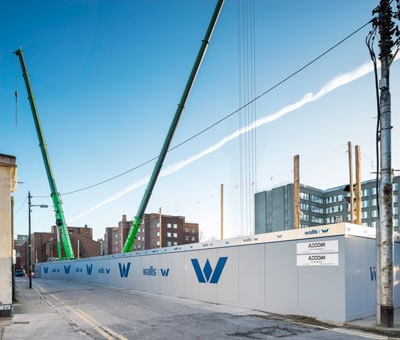 From this early engagement, their job was to ensure the smooth transition from completion of the enabling works through to the main construction works. “We were involved from the demolition phase of the existing premises, through to the installation of the perimeter secant wall and commencement of the basement bulk excavation. Our role was to provide advice to the project team on the management of the enabling works and monitor its progress, including dealing with everyday issues associated with a project in this inner city location. We recognised the importance of the site establishment due to the key challenges and construction site impacts on a local neighbourhood which included the existing LinkedIn offices business premises. We wanted to manage all of the neighbours’ expectations in terms of mitigating the impact of the project on the local community and to that end we ensured that the lines of communication which LinkedIn had already established with their neighbours were maintained throughout each phase of the project.“
From this early engagement, their job was to ensure the smooth transition from completion of the enabling works through to the main construction works. “We were involved from the demolition phase of the existing premises, through to the installation of the perimeter secant wall and commencement of the basement bulk excavation. Our role was to provide advice to the project team on the management of the enabling works and monitor its progress, including dealing with everyday issues associated with a project in this inner city location. We recognised the importance of the site establishment due to the key challenges and construction site impacts on a local neighbourhood which included the existing LinkedIn offices business premises. We wanted to manage all of the neighbours’ expectations in terms of mitigating the impact of the project on the local community and to that end we ensured that the lines of communication which LinkedIn had already established with their neighbours were maintained throughout each phase of the project.“
During construction of the building which is a six-storey building over single basement, approximately 400 concrete piles were installed to the building perimeter prior to the excavation of over 150 thousand tonnes of material to form the basement area. The concrete structure was completed with over 13 thousand cubic metres of concrete being poured, with some floor slab pours being in excess of 300 cubic metres. The exterior façade of the building consisted of over 900 Shuso unitised glazed panels with a feature Kilkenny Limestone spandrel. The roofing consisted of a Bauder reinforced bitumen membrane system with the installation of a sedum blanket to the upper-most roof area.
One of the most simple and effective tools that Walls and LinkedIn used to interface with their neighbours during the build was a dedicated project website, through which they could check out the progress of construction or raise any queries they had. This website was also utilised to provide information on any upcoming works which might impact the neighbourhood.
“It was clear to us how important the relationship with local residents was to the client, there was ongoing interaction with the local residents during the construction process and effort made to consider their views,” said Jonathan. “We knew that once we finished working on the site that we would move on to our next project, but it was important that a good relationship was established with the residents living beside the LinkedIn building once it became operational.“
Walls say that the level of interaction and personal time spent on interacting with the neighbourhood is now being implemented on their other projects.
 “There has been a change recently with the vast amount of construction that’s happening and people are becoming a lot more aware of what’s going on. We were nearly leading the charge in that respect in what we were doing down in LinkedIn. We had very little impact on the local area and that was a real success of the job,” Jonathan says.
“There has been a change recently with the vast amount of construction that’s happening and people are becoming a lot more aware of what’s going on. We were nearly leading the charge in that respect in what we were doing down in LinkedIn. We had very little impact on the local area and that was a real success of the job,” Jonathan says.
The formation of the construction methodology for the project, and particularly the basement and superstructure works, was also critical for ensuring the site was managed efficiently, and without impact to the wider area. Through their prior experience on similar projects, Walls Construction developed the site set-up with the use of two tower cranes, one at either end of the site and the installation of a placement boom for managing all concrete pours. Access to the site was limited to the Pembroke Row and Lad Lane elevations, so traffic and pedestrian management systems were put in place for these busy side streets.
During the later stages of the project, Walls Construction continued to work closely with the project team to finalise the details of the building design. “From producing tender packages for each element of the works, to reviewing and verifying each tender return and making recommendations to the project managers Aecom, this involvement was one of the biggest advantages of the management contract approach used on this project.”
It was important that we were involved in this level of detail to ensure quality, programme and cost certainty for LinkedIn. As a client, LinkedIn also wanted to be involved in every aspect of the building design, and that was critical to Walls in the successful delivery of the project”, says Jonathan Murphy.
What was the Walls project manager’s highlight of working on the building at Wilton Place? “For me, it was working for the client. I don’t think I’ve ever interfaced as closely with a client on a job before. Dealing directly with the Workplace Team – Annabel Heffernan, Eileen Slamon and Stephen Lynch – was such a pleasure and education for all parties. It was great to have LinkedIn involved in every process – there was detail involved in every step. As one example there are multiple joinery elements, floor and wall finishes and furniture items in the building, and working with RKD we went through every single aspect of the design drawings, materials selections and finishes with LinkedIn– that level of interaction was priceless. It was a fantastic process and it really helped us to define what the client wanted and deliver something they were happy with.”
One of the key challenges that Walls had to overcome on the project was the early occupancy by LinkedIn business of an entire floor of the building while construction works were still proceeding on surrounding floors. “LinkedIn had a business requirement to commence operations on the first floor in November of 2016, four months ahead of the overall project completion date. This was a big challenge for the team and became a sub project in itself ,” explains Jonathan.
“LinkedIn required work stations in place for over 200 people, but due to the nature of the building design and layout, together with a ‘can do approach’, we were able to facilitate this. The entrance at Lad Lane became LinkedIn’s entry point and we provided dedicated, safe and secure access to their works areas, which bypassed the building works which were still in progress on surrounding floors. Some minor temporary alterations to the design to enable this, including an approvals process with Dublin City Council were required to safeguard the LinkedIn team and ensure that the LinkedIn space was fully certified and that they would be able to work without being disturbed by the ongoing construction work. The entire process and the November move was seamless and a real success story of the project.”
Jonathan Murphy describes LinkedIn as dream clients, and cites their innovative approach, standards of excellence, family ethos and appreciation of their business team as just some of their most attractive qualities.
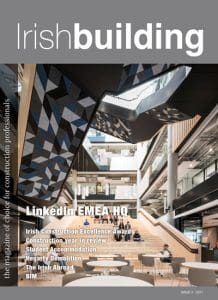 “You are much better off having a client actively involved during construction, asking all the questions and considering the design details, rather than having a client who doesn’t ask questions and is dissatisfied with the end result,” he says. “The most successful part of this project, and the building, is LinkedIn themselves and their involvement and engagement throughout the construction process.”
“You are much better off having a client actively involved during construction, asking all the questions and considering the design details, rather than having a client who doesn’t ask questions and is dissatisfied with the end result,” he says. “The most successful part of this project, and the building, is LinkedIn themselves and their involvement and engagement throughout the construction process.”
This article first appeared in Irish building magazine. Click here to read the entire issue
The content of this site is subject to copyright laws and may not be reproduced in any form without the prior consent of the publishers. The views expressed in articles do not necessarily represent those of the publishers.

